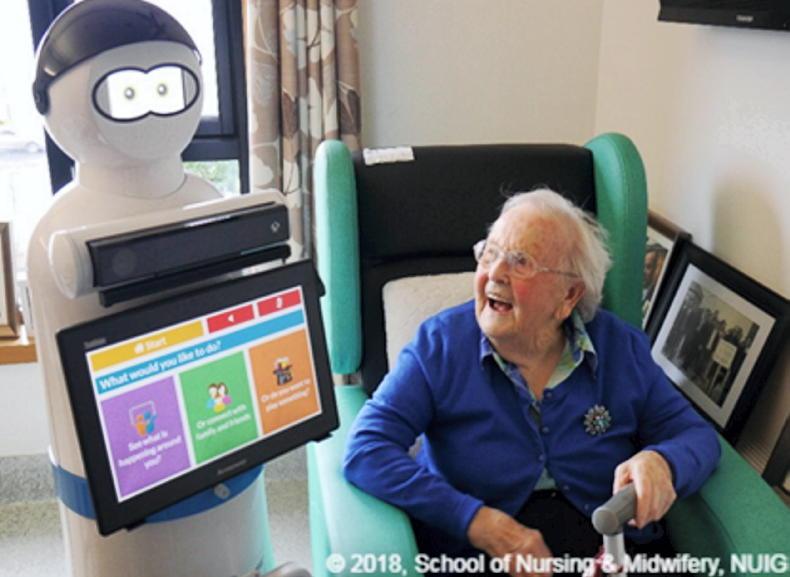Social robots will complement the work of carers and solve a skills shortage at a time when it is becoming increasingly difficult to get people into care jobs,” say Drs Perry Share and John Pender, joint coordinators of a project called PRoSPEro (the Pedagogy of Robotics in the Social Professions in Europe), who spoke at an online workshop organised by the Alzheimer Society of Ireland.
This project is currently developing training programmes for care professionals in the use of social robots, bringing practitioners and policy makers together and sharing international knowledge about the current state and future use of robots.
With 64,000 people in Ireland living with dementia right now and 7,000 new cases diagnosed each year (and overall figures expected to double in the next 25 years) strong demand is expected for social robots in the future.
They regard the current situation in relation to social robotics as day one of a long journey.
“Technology companies are investing hugely in the development of these robots, so it’s going to happen whether we like it or not,” they say.
But how exactly will social robots help on the care front?

MARIO the robot offers touchscreen and voice commands. \NUIG/Sligo IT
Already, support companions in the form of stand-up robots – like MARIO and Giraff – and comfort companions like PARO the harp seal pup and Joy for All cat or puppy robots (picture one and four) are being trialled in Ireland to determine their usefulness for those with dementia.
Much of the research is being done in association with the Alzheimer Society of Ireland by Institute of Technology Sligo (IT Sligo) and NUI Galway. These scientists are also liaising with others around the world, particularly Nordic countries, which are leading the way on the social robot front.
“About 80% of nursing homes in Denmark have a PARO therapeutic robot,” PhD student and occupational therapist Wei Qi Koh from NUIG pointed out.
Support to stay at home longer
With dementia predisposing people to depression and cognitive decline, Wei Qi says technology-based solutions and interventions need to be looked at in order to address their needs.
“Social robots can provide cognitive training, companionship, physiological therapy and social interaction,” she adds.
“They are not just intended to be used in care institutions. They can also support people to live at home for longer. The more functional technologies, like calendar and medication reminders and safety prompts, can help people in the earlier stages of dementia, for example.”
She listed the three types of robot currently available: social assistance robots, telepresence robots and pet robots (see table one).
“There’s no one-size-fits-all,” she explains. “It depends on what size and function best suits the person with dementia and what they want a robot to do for them.”
She spoke of how, in particular, the social robot Giraff has helped users.
“In Sweden, where this robot has been tested, users and families speak of it providing ‘a sense of presence’ in the home.
“It replaces the telephone or tablet, which some people with dementia can’t use correctly, and will also collect information like blood pressure and temperature readings. If the person has fallen, it will feed that information back to the caregiver.”
Stories from those using social robots
But how are some of the robots working out on the ground, so to speak?
Mary Hickey is manager of the Orchard Day Care Centre run by the Alzheimer Society in south Dublin.
The centre was asked by IT Sligo researchers to use PARO, the electronic harp seal pup, which can move its head, open and close its eyes, emit seal sounds and recognise faces and voices.
One woman who came to the centre five days a week would talk to it in the afternoon for an hour or so
“It is very tactile, very soft to touch and the weight of a newborn baby,” Mary says.
“While male clients have zero interest,” she says, “PARO does have appeal for female clients, particularly those in advanced stages of dementia.
“One woman who came to the centre five days a week would talk to it in the afternoon for an hour or so, even though – at that stage – she was not talking to family.
“It worked when she was in a calm state but not when she was agitated. PARO is programmed to shut down if a client is agitated and it remembers the times of day when the person wants him to be quiet.”
Not a silver bullet but has its place
You have to approach care from the needs of the individual, the manager says.
“It’s very nuanced. PARO or any other social robot is not a silver bullet but it does have its place with that particular cohort of people. Some people like to care for PARO too, and it is important for people with dementia to be caregivers as well as care recipients.”
The Hasbro Joy for All cat robot has also been tested at the Orchard centre.

JOY for ALL cat responds to touch.
“It’s lighter and easier to see and handle (PARO, being white, can make it difficult for some people with dementia to see),” Mary says of the cat robot.
Because Irish people are more familiar with cats than baby seals, the cat robot has more resonance for them, she has found. She would therefore consider cat and dog robots better in day care centres for providing companionship and comfort.
“For PARO, the aim is for a long-term relationship with a client, so he might work better in residential settings.
The cat and dog robots would be better in day care centres
“The cat isn’t as interactive. It goes through a cycle of movements – mewing, purring, rolling over and would do that whether you touched him or not – but he is very comforting for people to stroke. In many ways he can do more than PARO, but he doesn’t do it in response to the person. The cat and dog robots would be better in day care centres, in our experience.”
Will robots replace care staff?
“The technology is not far enough advanced for robots to replace caregivers – which is something that some carers have concerns about,” says Dr Sally Whelan of NUIG.
“It’s about supplementing human resources and providing additional resources for people with dementia.”
Dr Whelan spoke about the research in relation to MARIO the robot, which offers voice and touchscreen commands. MARIO is used in conjunction with a facilitator, which leads to a bond between the client and the carer. Photos and information can be saved to the client’s profile in the My Memories app on MARIO, for example.
“This reminiscence app is designed to evolve as the person offers more information,” Dr Whelan explains.
“For example, a client seemed to like a piece of music and said, when asked, that it reminded her of the song Jeanie with the light brown hair.
“That song was then programmed in for her next session with MARIO. MARIO is about facilitating people with dementia to communicate and engage in activities so it does have a role in combatting loneliness and reducing boredom.”
Ethical implications
Ethical implications of robots were also discussed, with concern expressed about how robots could impact on a person’s privacy.
There were fears of technology taking authority from people, but the experts are hoping people will see social robots as therapeutic tools rather than a sci-fi threat.
Dr Perry Share says, at present, social protections are lagging behind technology.
“Social robots aren’t on the regulatory horizon yet so there is a still a lot of work to be done.
“Regulators need to get ahead of the curve and start to think about these issues – better now than in ten years’ time trying to clean up the situation.”
Possible ethical concerns to address
While social robots are advertised as tools that can “be with us and interact with us”, experts believe robots shouldn’t judge actions or punish or reward action.There is the possible risk of humans forming an inappropriate attachment to the machine which might jeopardise social bonds.The risk of excessive autonomy for the machine – together with a loss of human control.Anthropomorphic traps: vulnerable people believing the robot is human.
Social robots will complement the work of carers and solve a skills shortage at a time when it is becoming increasingly difficult to get people into care jobs,” say Drs Perry Share and John Pender, joint coordinators of a project called PRoSPEro (the Pedagogy of Robotics in the Social Professions in Europe), who spoke at an online workshop organised by the Alzheimer Society of Ireland.
This project is currently developing training programmes for care professionals in the use of social robots, bringing practitioners and policy makers together and sharing international knowledge about the current state and future use of robots.
With 64,000 people in Ireland living with dementia right now and 7,000 new cases diagnosed each year (and overall figures expected to double in the next 25 years) strong demand is expected for social robots in the future.
They regard the current situation in relation to social robotics as day one of a long journey.
“Technology companies are investing hugely in the development of these robots, so it’s going to happen whether we like it or not,” they say.
But how exactly will social robots help on the care front?

MARIO the robot offers touchscreen and voice commands. \NUIG/Sligo IT
Already, support companions in the form of stand-up robots – like MARIO and Giraff – and comfort companions like PARO the harp seal pup and Joy for All cat or puppy robots (picture one and four) are being trialled in Ireland to determine their usefulness for those with dementia.
Much of the research is being done in association with the Alzheimer Society of Ireland by Institute of Technology Sligo (IT Sligo) and NUI Galway. These scientists are also liaising with others around the world, particularly Nordic countries, which are leading the way on the social robot front.
“About 80% of nursing homes in Denmark have a PARO therapeutic robot,” PhD student and occupational therapist Wei Qi Koh from NUIG pointed out.
Support to stay at home longer
With dementia predisposing people to depression and cognitive decline, Wei Qi says technology-based solutions and interventions need to be looked at in order to address their needs.
“Social robots can provide cognitive training, companionship, physiological therapy and social interaction,” she adds.
“They are not just intended to be used in care institutions. They can also support people to live at home for longer. The more functional technologies, like calendar and medication reminders and safety prompts, can help people in the earlier stages of dementia, for example.”
She listed the three types of robot currently available: social assistance robots, telepresence robots and pet robots (see table one).
“There’s no one-size-fits-all,” she explains. “It depends on what size and function best suits the person with dementia and what they want a robot to do for them.”
She spoke of how, in particular, the social robot Giraff has helped users.
“In Sweden, where this robot has been tested, users and families speak of it providing ‘a sense of presence’ in the home.
“It replaces the telephone or tablet, which some people with dementia can’t use correctly, and will also collect information like blood pressure and temperature readings. If the person has fallen, it will feed that information back to the caregiver.”
Stories from those using social robots
But how are some of the robots working out on the ground, so to speak?
Mary Hickey is manager of the Orchard Day Care Centre run by the Alzheimer Society in south Dublin.
The centre was asked by IT Sligo researchers to use PARO, the electronic harp seal pup, which can move its head, open and close its eyes, emit seal sounds and recognise faces and voices.
One woman who came to the centre five days a week would talk to it in the afternoon for an hour or so
“It is very tactile, very soft to touch and the weight of a newborn baby,” Mary says.
“While male clients have zero interest,” she says, “PARO does have appeal for female clients, particularly those in advanced stages of dementia.
“One woman who came to the centre five days a week would talk to it in the afternoon for an hour or so, even though – at that stage – she was not talking to family.
“It worked when she was in a calm state but not when she was agitated. PARO is programmed to shut down if a client is agitated and it remembers the times of day when the person wants him to be quiet.”
Not a silver bullet but has its place
You have to approach care from the needs of the individual, the manager says.
“It’s very nuanced. PARO or any other social robot is not a silver bullet but it does have its place with that particular cohort of people. Some people like to care for PARO too, and it is important for people with dementia to be caregivers as well as care recipients.”
The Hasbro Joy for All cat robot has also been tested at the Orchard centre.

JOY for ALL cat responds to touch.
“It’s lighter and easier to see and handle (PARO, being white, can make it difficult for some people with dementia to see),” Mary says of the cat robot.
Because Irish people are more familiar with cats than baby seals, the cat robot has more resonance for them, she has found. She would therefore consider cat and dog robots better in day care centres for providing companionship and comfort.
“For PARO, the aim is for a long-term relationship with a client, so he might work better in residential settings.
The cat and dog robots would be better in day care centres
“The cat isn’t as interactive. It goes through a cycle of movements – mewing, purring, rolling over and would do that whether you touched him or not – but he is very comforting for people to stroke. In many ways he can do more than PARO, but he doesn’t do it in response to the person. The cat and dog robots would be better in day care centres, in our experience.”
Will robots replace care staff?
“The technology is not far enough advanced for robots to replace caregivers – which is something that some carers have concerns about,” says Dr Sally Whelan of NUIG.
“It’s about supplementing human resources and providing additional resources for people with dementia.”
Dr Whelan spoke about the research in relation to MARIO the robot, which offers voice and touchscreen commands. MARIO is used in conjunction with a facilitator, which leads to a bond between the client and the carer. Photos and information can be saved to the client’s profile in the My Memories app on MARIO, for example.
“This reminiscence app is designed to evolve as the person offers more information,” Dr Whelan explains.
“For example, a client seemed to like a piece of music and said, when asked, that it reminded her of the song Jeanie with the light brown hair.
“That song was then programmed in for her next session with MARIO. MARIO is about facilitating people with dementia to communicate and engage in activities so it does have a role in combatting loneliness and reducing boredom.”
Ethical implications
Ethical implications of robots were also discussed, with concern expressed about how robots could impact on a person’s privacy.
There were fears of technology taking authority from people, but the experts are hoping people will see social robots as therapeutic tools rather than a sci-fi threat.
Dr Perry Share says, at present, social protections are lagging behind technology.
“Social robots aren’t on the regulatory horizon yet so there is a still a lot of work to be done.
“Regulators need to get ahead of the curve and start to think about these issues – better now than in ten years’ time trying to clean up the situation.”
Possible ethical concerns to address
While social robots are advertised as tools that can “be with us and interact with us”, experts believe robots shouldn’t judge actions or punish or reward action.There is the possible risk of humans forming an inappropriate attachment to the machine which might jeopardise social bonds.The risk of excessive autonomy for the machine – together with a loss of human control.Anthropomorphic traps: vulnerable people believing the robot is human. 










SHARING OPTIONS